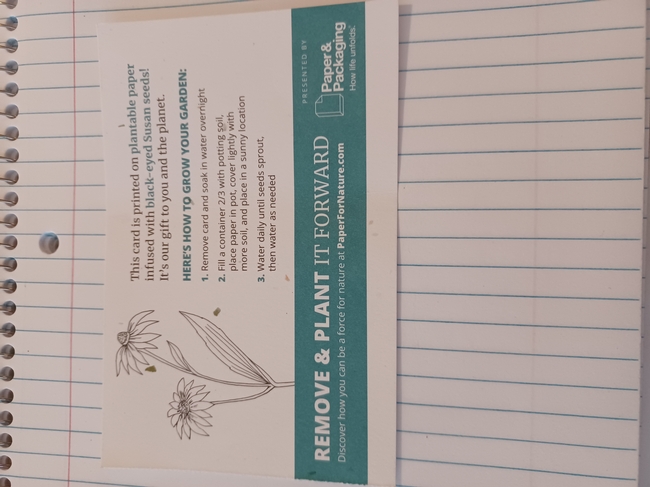Magazine Present-Black-eyed Susan Paper
I was reading through some recipe magazine that was in the pile on my table and there was this card (pictured)
in the center. Generally, I tear them out or fold them out of the way, but the flower caught my attention. Then, I
thought, "I need to plant this paper right away." Common sense prevailed, and I said to myself, "You know, it's
November and not the right time to plant much. You need more information than what is on this card."
Off to the Internet and the Sunset Western Garden Book to find said information.
The Black-eyed Susan is also known as Rudbeckia, and there are a couple of varieties to be found. It is also called
Brown Betty, hairy coneflower, Marguerite, and Jaune. It is from the Asteraceae family and looks like a daisy with
scratchy, hairy leaves. It is a fast-growing perennial with yellow to orange flowers with large seed heads which make it
self-seed readily. It is a native wildflower plant that grows all over the Eastern and Central U.S. The Spruce site said that it is native to Hardiness zones 3 - 7, but the Sunset Western Garden Book said zones 3 - 24. (So it will grow here.) If you are planting a garden with the goal of attracting pollinators, Rudbeckia would be a good addition to the garden. Companion plants include salvia and other pollinator-attracting plants and color-wise, works well with plants with blue and purple flowers. It attracts insects also, so be prepared. Planting near rosemary or lavender can help decrease the insect interest if you want.
When browsing around the Internet, I found that many of the bulb sites offer Rudbeckia for sale, so I went to the Michigan Bulb Company site because they have good pictures of what you will receive in your order. What they send out is a clump of roots to be planted soon after receipt. This made sense since all the sites described it as a clumping plant. The nice thing is that you do not have to separate the plant unless it outgrows its space, or you want to, as the center of the clump does not die out.
Now for the planting and care instructions. Seeds can be started indoors, but need to be kept cold for about 4 weeks. Or you can plant directly outdoors after the last frost, or when daytime temperatures reach about 60 degrees F. They do well in full sun to light partial shade, in moist to dry, fast-draining soil with a pH of about 6.8. During the first season, they need regular watering but become drought tolerant as they mature. GardeningKnowHow.com says that they require very little care, except for dead-heading to promote more flowering and pruning down after the summer-long flowering season comes to an end. Prune down to about 2 inches above the ground in the fall, and to ground level and cover with mulch as frosts approach. They prefer compost to fertilizer and sometimes need to be thinned to promote air circulation and decrease the incidence of powdery mildew. If you are a person who likes to collect seeds, simply let the flower heads dry on the stem then cut them off before the seeds spill out.
So, my plan for this little gift is to try not to lose the paper and plant as directed in the spring. I have a pot sitting empty that will be perfect for this gift, and maybe a store-bought cousin.



Posted by Michelle’s on March 10, 2024 at 11:38 AM